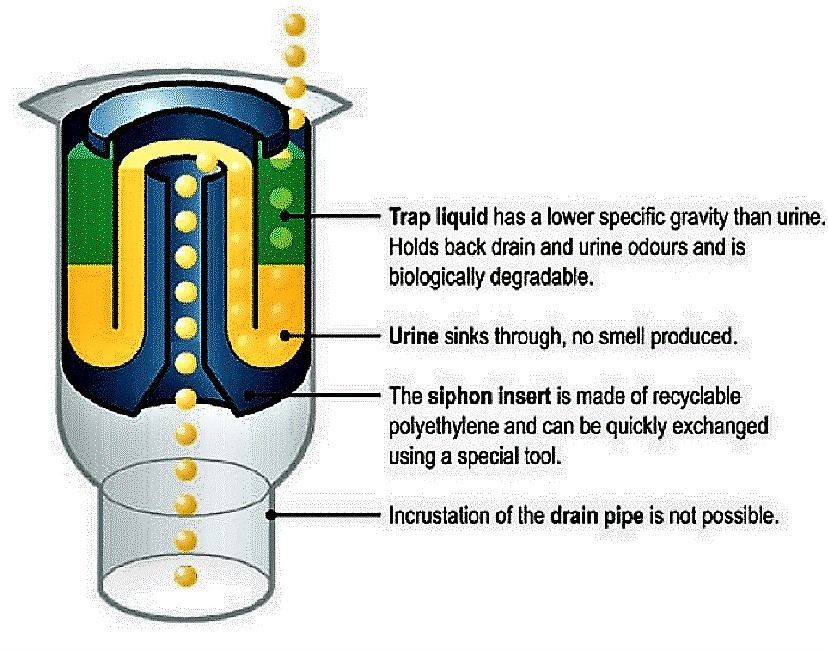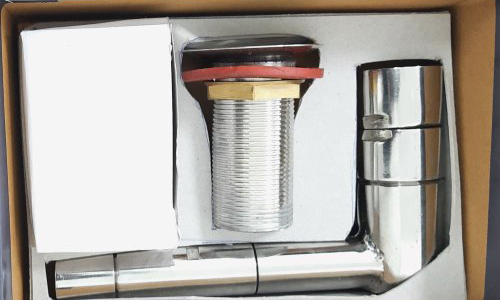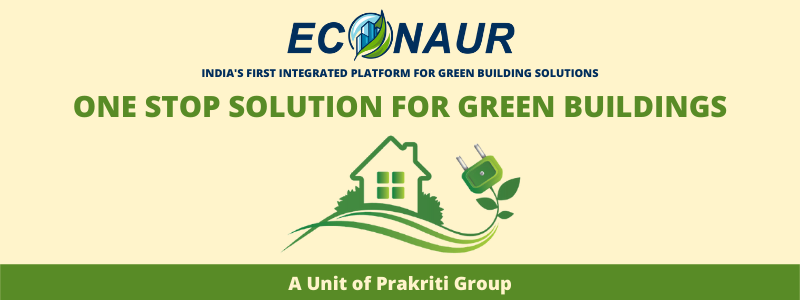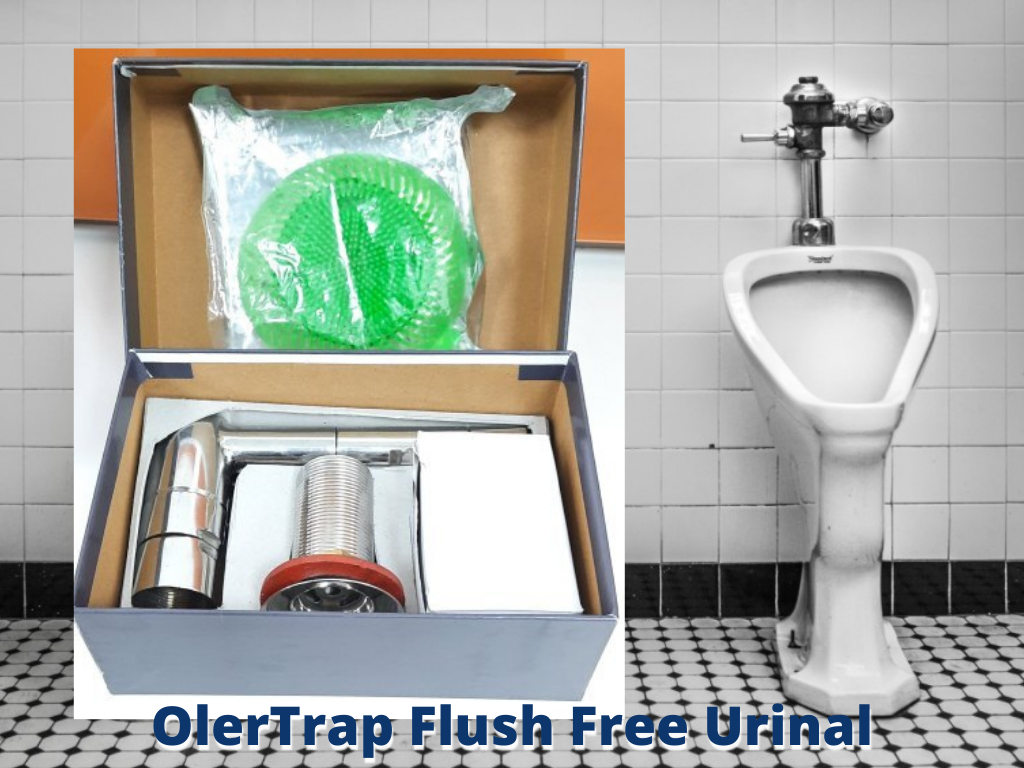OlerTrap Flush Free Urinal has been proven to conserve water and save money while reducing maintenance time and cost, as well as creating cleaner, odour-free, touch-free, and more hygienic restroom environments.
Waterless Urinals do not require water for flushing and can be promoted at homes, organisations and public places to save water, energy and to harvest urine as a resource. Reduction in infrastructure required for water supply and wastewater treatment is also a spinoff deriving from installing waterless urinals. The concept, founded on the principles of ecological sanitation helps in preventing environmental damage caused by conventional flush sanitation systems.
Waterless urinals look very much like conventional urinals in design and these can be utilised in the same manner. However, waterless urinals do not require water for flushing and thus result in saving anything between 56,800 litres to 1, 70,000 litres of water per urinal per year.
However, with reckless abuse and increasing demand, due to the growing population and unsustainable lifestyle, many countries are facing severe water crises.

Although depletion of water resources is a major issue, flushing toilets & Urinals is not typically recognized as a cause. But each flush uses at least 1.6 litres of water. Water is needed to ensure food security, feed livestock, maintain organic life, take up industrial production and conserve the biodiversity and environment.
Waterless urinals do not need water and expensive plumbing accessories are usually required for flushing. Also, the dry operation of waterless urinals and touch-free operations reduce the spreading of communicable diseases. Odour trap mechanisms using sealant liquid, microbial control, membrane and curtain valve fitted to waterless urinals assist in preventing odour developing inside the drainage lines connected to urinals.
Urinal
The traditional method of removing odour is flushing of Urinal Pan with water, which dilutes & transport the urine into the mainline from the drainpipe. However, it requires a huge amount of water.
Since urine is mostly water, it does not require any extra water for its regular smooth flow into the main sewer line, when urine mixes with water it produces Ammonia which is responsible for the smell. Based on this concept, KOSHISH developed a mechanical means to reduce the odour and to conserve water – The OlerTrap Flush Free and Odour Free Urinal Kit.
OlerTrap Flush Free Urinals consist of a robust and conservative design, keeping in consideration the rough usage and abuse often encountered with typical Indian Urinals.
- No flush system reduces the load on STPs, Sewer lines, water management and saves on sensor cost, pumping cost, and maintenance as well.
- Helps in Green Building accreditation and supports Sustainability and Environmental Goals (EHS).
- Washable Retrofit Unit (no capital expenditure repeatedly).
- Can be installed and maintained by anyone (DIY).
- No choking.
The prime concern of a waterless or flush free urinal is to block the path of foul gases (generated in the drain pipelines due to natural degradation of urine) exiting through the urinal holes, hence removing odour into the restroom.
Process
A waterless urinal looks very much like a conventional urinal. Many times, all that is different is the away flush valve or piping that normally sits above the unit (because waterless urinals, as the name implies, don’t need water to operate).
Instead, waterless systems have a vertical-trap design that incorporates a cylinder or trap filled with a thin layer of liquid sealant sitting atop the drain area of the urinal. Urine passes through the cylinder and bond; as the cylinder fills, it flows under the barrier layer and into the waste line, where it is drained – much the same way as a conventional urinal works.
Since the urinal surface is dry, it helps inhibit bacteria growth and odour and makes the unit easier to clean. Additionally, there are no water depositions or rust stains to build up as with a water-based urinal.

Although there are some differences depending on the manufacturer, cleaning a waterless urinal follows most of the same steps and procedures as a conventional urinal:
- Wear gloves (and goggles) to clean any restroom fixture.
- Remove any foreign objects in the urinal. The trap is designed to prevent larger objects from entering the drain area.
- Do not use abrasive cleaners, towels, or brushes.
- Mist all urinal surfaces with a neutral or all-purpose cleaner, or use a Johnny Mop with water and cleaner on all surfaces.
- Allow for dwell time (if indicated by the chemical manufacturer).
- Wipe clean with a soft sponge, a Johnny Mop dipped in a bucket of clean water, or a cleaning cloth.
- Dry the surfaces with a soft cloth.
- Do not pour excess or soiled water down the waterless urinal trap – it can flush the sealant out of the trap insert.
Flushing with water is employed to control odour in the conventional urinals whereas waterless urinals utilise odour control mechanisms. Waterless urinals require regular cleaning routines similar to conventional urinals based on the number of users. However, waterless urinals can be cleaned using a moist sponge or brush without the use of water.
Installation and Maintenance of Waterless Urinals
Waterless Urinal System
• An appropriate type of waterless urinal odour trap can be chosen based on the location to be installed, investment cost, maintenance costs and easy availability of spares.
• Maintenance instructions of the manufacturer to optimise the performance of the odour traps must be followed.
• Cleaning staff must wear gloves and face masks while attending maintenance works.
• Users of urinal must be educated to avoid spitting and throwing cigarette butts and chewing gum in the urinal pans.
Advantages
Waterless urinals do not require a constant source of water Can be built and repaired with locally available materials Low capital and operating costsWaterless urinals produce fewer odours than urinals with water flush and also have no problems with urinal cakes (odour and urinal cakes occur when urine is mixed with water)Waterless urinals contribute to water saving at the greatest possible degree Waterless urinals allow the pure and undiluted collection of urine for reuse, e.g. as fertilizer in urban farming (after appropriate treatment, e.g. storage) and can contribute to the closed-loop economy, or for effective anaerobic treatment by e.g. an anaerobic ammonium oxidation (anammox) reactor surface water and aquifers are protected from nutrients and pharmaceuticals if the urine is collected separately.
Disadvantages
In case of replacement of odour trap seal, the maintenance staff needs to be instructed how to replace the seal when necessary and how to wash the fixture. However, no skilled personnel are requiredThe use of microbial blocks may cause pollution concerns in case of reuse of urine in agriculture and is therefore not recommended problems with odours may occur if not used and maintained correctly models for women are not widely available.
Benefits of the Waterless Approach
Our urinals save more than just water: they save time and money. The upkeep of traditional flush urinals can be expensive, and maintenance in particular instances can take hours. Our waterless fixtures eliminate the need for flush valve repairs, waste line cleanouts, deodorizers, and blockage removals.
We know that you will love the simplicity of our waterfree urinals. We have a lot more information on our practice, so please reach out if you ever find yourself asking “how do waterless urinals work?” We will be happy to provide you with more information.
Advantages
Public toilets that are badly designed, badly maintained, and poorly located generate a sense of neglect, attracting vandalism, anti‐social behaviour and social disorder. Poor quality of construction and inappropriate designs of urinals lead to improper use of facilities in most cases. As a result, most urinals suffer from the vicious cycle of bad use and improper construction or maintenance. Waterless urinals are a good option to be considered while promoting public urinals because they overcome the need for water as well as the infrastructure required for conventional urinals.
The unmanned public urinals usually constructed on streets and fewer density areas can be improved to provide a better aesthetic and environment to the user. Quality of construction is an issue in most of such stand-alone urinals constructed in less crowded areas.

Water saving
One of the biggest advantages of this type of urinal is its water-saving characteristic. It is waterless, hence there is no water wasted to clean and use it. Although the urinal price is not always friendly, you will be happy to know that you can enjoy huge savings when using and maintaining it.
Low maintenance
This is one of the things people do not know about waterless urinals. The low maintenance is due to the fact that it does not require valve rehabilitation and it never gives issues both on overflowing and clogging, unlike its counterparts. Spending money to pay professional plumbing services is not something to think about even in the long run.
Environment friendly
Any furniture or item that does not require the usage of natural resources is indeed environmentally friendly. And since there is no water needed to flush or wash it, there is no water required to be treated. This is a perfect choice for people who have high concerns for the environment.
Comparison with Conventional Urinal
| 0.5-1L water per flush per urinal | No flush required |
| High cleaning and maintenance cost, requires frequent cleaning and washing of the urinals | No extra cleaning and maintenance cost, it requires cleaning once in 2 days (regular use of spray is required) |
| Sensor Cost / Power Consumption / Battery Replacement | No Recurring Cost and No Power Required |
| Frequent Chocking | No Chocking |
| Produce high odour | Neutralized odour |
Maintenance
Undertaking proper maintenance routines of waterless urinals installed is essential for ensuring their effective functioning. Improper maintenance of the waterless urinals may result in the failure of this novel concept.
Future Consideration
Therefore, sensitizing the users, training of maintenance staff and allocation of adequate budget for meeting the maintenance requirements must be ensured after installation of waterless urinals.
Tags: Conventional Flush Sanitation Systems, Waterless Urinals, Washable Retrofit Unit, Deodorizer.


